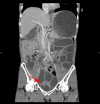Perioperative Infusion Management for Adhesive Bowel Obstruction with Congenital Nephrogenic Diabetes Insipidus: A Case Report
- PMID: 37229364
- PMCID: PMC10203649
- DOI: 10.33160/yam.2023.05.015
Perioperative Infusion Management for Adhesive Bowel Obstruction with Congenital Nephrogenic Diabetes Insipidus: A Case Report
Abstract
Congenital nephrogenic diabetes insipidus (CNDI) is a rare disease that results in polyuria due to decreased responsiveness to the antidiuretic hormone in the collecting ducts of the kidney. Without compensation by drinking large amounts of water, dehydration and hypernatremia can rapidly develop. We present a case of a patient originally diagnosed with CNDI who required surgery and a fasting period due to adhesive bowel obstruction. The patient was a 46-year-old man who was originally diagnosed with CNDI. He was prescribed trichlormethiazide but self-discontinued treatment in the process. His normal urine output was about 7,000-8,000 mL/day. He underwent robot-assisted radical cystectomy and uretero-cutaneostomy for bladder cancer. Two years later, he was hospitalized due to adhesive bowel obstruction. A 5% glucose solution was infused, and the dose was adjusted according to the urine volume and electrolytes. An adhesiotomy was performed due to recurrent bowel obstruction in a short period of time. A 5% glucose solution was used as the main infusion during the perioperative period. Once drinking water was resumed after surgery, urinary output and electrolytes were easily controlled. In conclusion, patients with CNDI should be given a 5% glucose solution as the primary infusion, and the infusion volume should be adjusted by monitoring daily urine output, electrolytes, and blood glucose levels. Infusion management is easier if oral intake is initiated as early as possible.
Keywords: diabetes insipidus; infusions; intravenous; nephrogenic; perioperative period.
©2023 Tottori University Medical Press.
Conflict of interest statement
The authors declare no conflicts of interest.
Figures



Similar articles
-
Growth failure in an infant with congenital nephrogenic diabetes insipidus during sodium restriction.Clin Pediatr Endocrinol. 2007;16(4):95-8. doi: 10.1297/cpe.16.95. Epub 2007 Nov 17. Clin Pediatr Endocrinol. 2007. PMID: 24790353 Free PMC article.
-
A Case of Congenital Nephrogenic Diabetes Insipidus Caused by Thr108Met Variant of Aquaporin 2.Front Pediatr. 2020 Jan 30;8:15. doi: 10.3389/fped.2020.00015. eCollection 2020. Front Pediatr. 2020. PMID: 32083042 Free PMC article.
-
Case Report: A Case of Congenital Nephrogenic Diabetes Insipidus Caused by Thr273Met Mutation in Arginine Vasopressin Receptor 2.Front Pediatr. 2021 Jul 15;9:707452. doi: 10.3389/fped.2021.707452. eCollection 2021. Front Pediatr. 2021. PMID: 34336746 Free PMC article.
-
[Vasopressin V2 receptor-related pathologies: congenital nephrogenic diabetes insipidus and nephrogenic syndrome of inappropiate antidiuresis].Nephrol Ther. 2014 Dec;10(7):538-46. doi: 10.1016/j.nephro.2014.09.002. Epub 2014 Oct 25. Nephrol Ther. 2014. PMID: 25449762 Review. French.
-
[Pathological aspects of water transport in the collecting ducts].Nephrologie. 1996;17(7):417-22. Nephrologie. 1996. PMID: 9019668 Review. French.
Cited by
-
Extreme hypernatremia after a laparoscopic hysterectomy and bilateral salpingo-oophorectomy: a case report and literature review.Front Surg. 2024 Oct 15;11:1462525. doi: 10.3389/fsurg.2024.1462525. eCollection 2024. Front Surg. 2024. PMID: 39474227 Free PMC article. Review.

